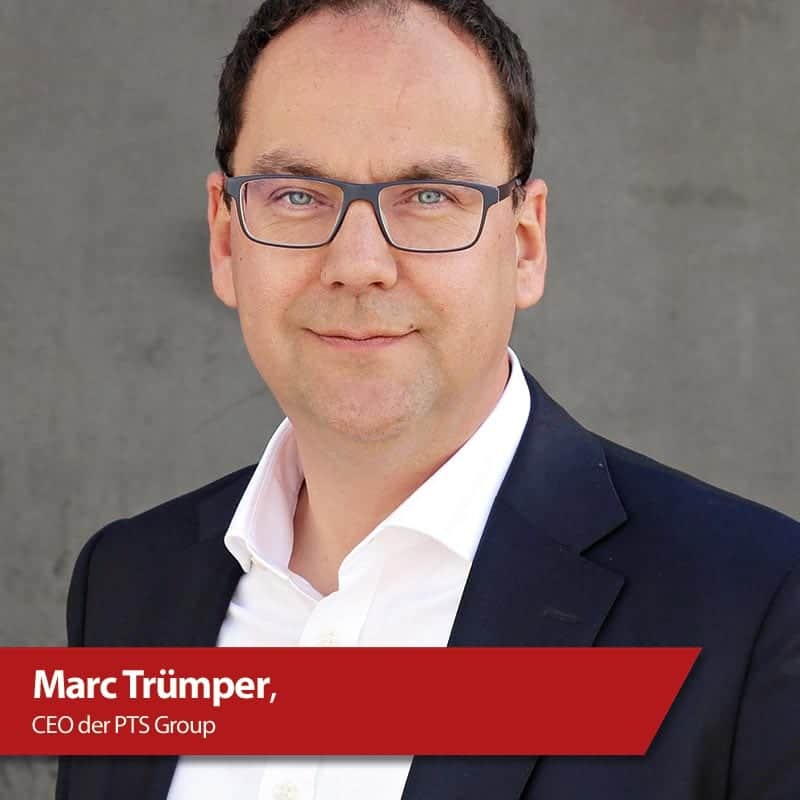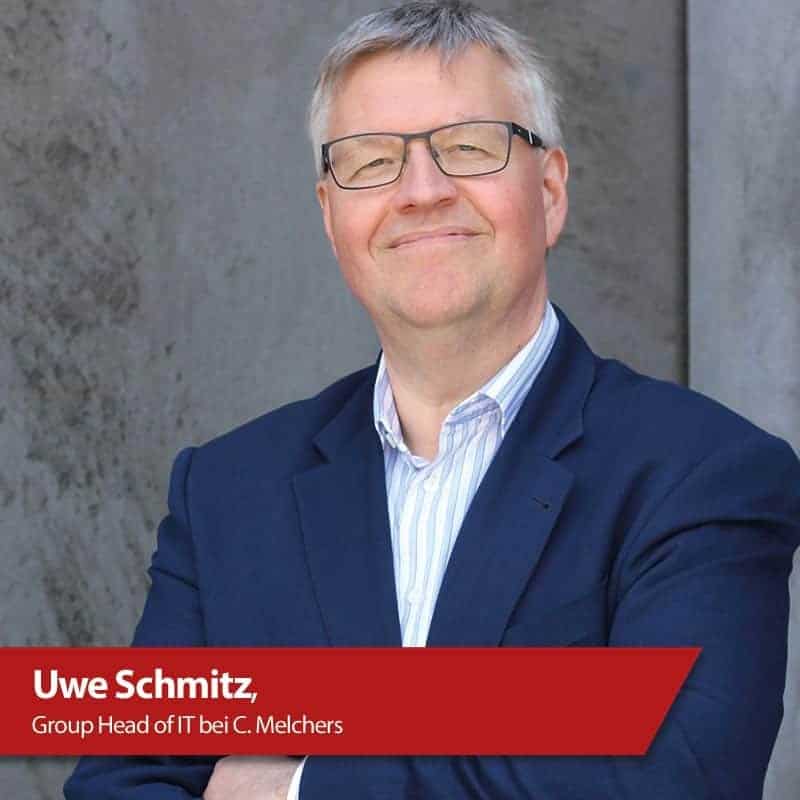Cloud Change Management
![[shutterstock.com: 326703500, Khakimullin Aleksandr]](https://e3mag.com/wp-content/uploads/2020/05/shutterstock_326703500.jpg)

What this is all about in concrete terms and what weighting is attached to change management and cloud computing is the subject of an interview with Uwe Schmitz by PTS Group CEO Marc Trümper and long-time customer C. Melchers.
Marc Trümper: Mr. Schmitz, please introduce yourself briefly: Who are you, where do you work and what is your role?
Uwe Schmitz: I have been working for the Melchers Group since 1998 and in my position as Group Head of IT I am the contact person in all disciplines of digitalization. I am therefore responsible for the further development of the IT services of the Melchers Group within the framework of our digital strategy.
Trümper: When you get up in the morning, what issues occupy you and what moves you in your daily work?
Schmitz: Our employees use a wide range of communication and information channels in their day-to-day work. Their work is strongly influenced by functioning information technology.
Providing these, operating them securely and cost-effectively, and constantly developing them in line with the needs of our employees moves me all day long.
Trümper: And in the current situation?
Schmitz: In the current crisis, we are very clearly seeing a change in the demands placed on employees - much more so than before. We are seeing an unchecked rise in digital communication, with audio and video conferencing taking the place of face-to-face meetings.
Employees are increasingly working independently of time and location. IT is called upon to lead the change and accompany the employees. However, this can only go hand in hand with a cultural change in the company and society. Acceptance must be created and maintained so that employees are not left behind.

Trümper: In 2018, you made the decision to move your IT systems to the Microsoft Cloud with the PTS Group. When was it clear to you that the future of your IT landscape lay in the cloud?
Schmitz: First, there was an attractive offering of technology in the cloud from Microsoft. Our journey began by learning about this offering and determining the deployment benefits for the Melchers Group.
In addition, some outdated systems urgently needed to be replaced. This fitted in well with the increasingly loud demand from the ranks of employees to want to work in a mobile and flexible manner.
Trümper: What was at the beginning?
Schmitz: With the Office 365 product and the digital collaboration and information sharing options it offers, we had the right starting point.
The change in our Exchange landscape then tipped the scales and created enthusiasm. The employees became aware of the advantages of these products more quickly in daily use than in lengthy training sessions.
Mobility and working independently of time and place were already requested before the Corona crisis and could be made possible in this way.
Trümper: So the beginning of change management, right?
Schmitz: Yes, this has led to a rethink, as the previous IT landscape was not up to these requirements in times of the global wave of digitization.
The required flexibility is provided by the Azure Cloud with its various IaaS, PaaS and SaaS offerings. Particularly important to us are the scalability of the IT landscape, global availability, but also the possibilities for cost control and reduction. The Azure Cloud offers optimization potential.
Trümper The basic IT strategy must take various components into account. When you think back to the decision-making phase, what was your first step into the cloud?
Schmitz: As is well known, all beginnings are difficult. The first step was to collect and evaluate information together with competent partners. In the course of this, we were also in direct contact with Microsoft.
This involves sounding out the potential of the solutions and assessing their suitability for use in the company. This is a bumpy start, which also involves selecting and involving the right partners on the way to the cloud.
Trümper: One component of your cloud strategy is also the migration of your SAP systems to the Microsoft Cloud. What do you expect from the use of SAP on Azure?
Schmitz: We see various advantages when using an SAP system in the MS Azure Cloud: One important factor is the reduction in operating costs. The change of the operating system to Linux plays a role here, as does the time-flexible operation of individual components of the SAP landscape, such as E and Q systems.
Moving from "on demand" operations to "reserved instances" allows costs to be planned. Flexibility in scaling the systems has been a critical factor:
The constant further development of individual systems came up against physical and virtual limits. In some cases, it was simply not possible to scale back extensions. Today, we rely on full flexibility in scaling up and down.
Trümper: Besides this flexibility, are there other improvements?
Schmitz: In addition, we expect a significant improvement in the performance of our mobile applications, which was not possible in this form before. We can also create synergies by shifting operations and SAP Basis support to a partner such as the PTS Group.
Ultimately, SAP operation in the Azure Cloud also requires coordinated network segmentation and protection to the Internet and other network areas in our hybrid infrastructure as part of our IT security strategy.

Trümper: You've already mentioned comprehensive preparation, and implementation alone is not enough - the best technology only works if people accept it.
Schmitz: First and foremost, with information that serves to educate the employee about the opportunities of the digital transformation. We also focus on support: We demonstrate the use of new technologies in old and new processes and the associated optimization potential.
We are trying to create a new awareness regarding the risks of cybercrime. It's a total package to take our employees on this journey.
Trümper: People, culture, places, technology - these are all factors that determine the journey. Melchers is a traditional company with a great deal of influence from Asia and thus has some experience in terms of technological change and cultural differences.
Schmitz: The Melchers Group accompanies its customers as a global service provider on their way to the markets in the Far East, especially to China. Communication, cooperation and information exchange on the way to these markets are a focus of our activities. We initiated the changes about two years ago. Initially with information events for management and employees.
Trümper: Have you already implemented changes on this scale in the past? What experience have you gained? Were you able to identify key success factors for yourself?
Schmitz: The SAP project was preceded by the switch to Office 365 and Exchange Online and the establishment of a secure infrastructure in Azure. We then migrated our EDI landscape to Azure and built Citrix on Azure.
The SAP project was and is nevertheless unique and a first step in the direction of S/4 Hana. Nevertheless, we are drawing on the experience and know-how from the cloud projects we have already carried out.
Trümper: Finally, a gift for readers under the motto "Learning from others: What can you take away from this project? What can you pass on?
Schmitz: Sharing experiences and communicating across company boundaries helps to sort out the flood of information on the subject of Azure Cloud and adapt it to one's own needs.
In this context, workshops with companies of a similar size and nature are also a means of choice, as is direct exchange with IT managers from other companies.
Furthermore, I can recommend a trustful exchange and cooperation with partners who enable and support this exchange.
Global player with personality
C. Melchers GmbH & Co. KG, founded in Bremen in 1806, is one of the leading service providers for all companies wishing to gain a foothold in the markets of the future. In Asia in particular, it has knowledge and infrastructures that have grown over 150 years into a broad portfolio of services and trading expertise in a wide range of business areas. A network of more than 50 subsidiaries in Germany and abroad makes Melchers a reliable, strong partner for off- as well as online market development.
Comment Marc Trümper, CEO PTS Group
The example of the Melchers Group shows that the transformation of the IT infrastructure and the use of cloud solutions are only one side of the coin and, in addition to the technical component, primarily affect people.
In its service provision, the service provider leaves the area of purely technical implementation and, as a partner, takes on a wider range of consulting services and a partially new area of responsibility.
In doing so, he has to come up with solutions to new questions. "How do I not lose employees along the way & make them cloud ready?", "How do I keep track of my costs?" and "How do I ensure my data is secure in the cloud?" are just a few examples here.
Cloud projects must not be seen as rigid undertakings or as research projects with a corset of a fixed start and defined end. They should be seen as a continuous process of enlightenment.
After all, it is easier to remedy failures in technical digitization gaps than it is to remedy failures in employee training and development. Consistent consideration of adoption and change management is necessary to sustainably support the cultural change in the company and to prevent the journey to the cloud from becoming a blind flight for employees.
The Melchers Group, also with the consulting expertise of the PTS Group and other partners, has left the focus on the core business and purely technical approach to digitization within the IT organization and has opened up for a cultural change through constant work on established structures.
The Melchers Group can now reap the rewards: Cloud awareness has been created, hybrid or purely cloud-focused infrastructures are no longer foreign bodies.
Digitization measures are approached with optimism and self-confidence, and internal multipliers ensure that one thing is not forgotten: After the change is before the change.




